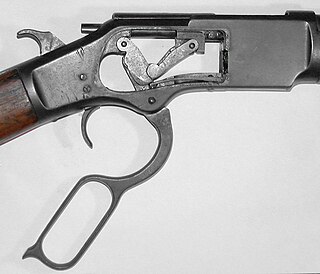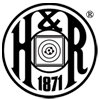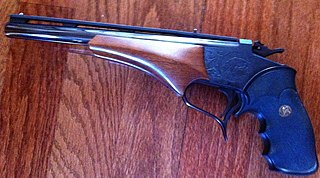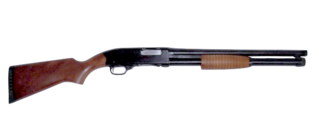
A shotgun is a long-barreled firearm designed to shoot a straight-walled cartridge known as a shotshell, which discharges numerous small spherical projectiles called shot, or a single solid projectile called a slug. Shotguns are most commonly used as smoothbore firearms, meaning that their gun barrels have no rifling on the inner wall, but rifled barrels for shooting sabot slugs are also available.
The Winchester Model 1897, also known as the Model 97, M97, Riot Gun, or Trench Gun, is a pump-action shotgun with an external hammer and tube magazine manufactured by the Winchester Repeating Arms Company. The Model 1897 was an evolution of the Winchester Model 1893 designed by John Browning. From 1897 until 1957, over one million of these shotguns were produced. The Model 1897 was offered in numerous barrel lengths and grades, chambered in 12 and 16 gauge, and as a solid frame or takedown. The 16-gauge guns had a standard barrel length of 28 in (71 cm), while 12-gauge guns were furnished with 30 in (76 cm) barrels. Special length barrels could be ordered in lengths as short as 20 in (51 cm) or as long as 36 in (91 cm). Since the time the Model 1897 was first manufactured, it has been used to great effect by American military personnel, law enforcement officers, and hunters.

A lever action is a type of action for repeating firearms that uses a manually operated cocking handle located around the trigger guard area that pivots forward to move the bolt via internal linkages, which will feed and extract cartridges into and out of the chamber, and cock the firing pin mechanism. This contrasts to other type of repeating actions such as the bolt-action, pump-action, semi-automatic, fully automatic, and/or burst mode actions. A firearm using this operating mechanism is colloquially referred to as a levergun.
Savage Arms is an American gunmaker based in Westfield, Massachusetts, with operations in Canada and China. Savage makes a variety of rimfire and centerfire rifles, as well as Stevens single-shot rifles and shotguns. The company is best known for the Model 99 lever-action rifle, no longer in production, and the .300 Savage. Savage was a subsidiary of Vista Outdoor until 2019 when it was spun off.

The Mossberg 500 (M500) is a series of pump-action shotguns manufactured by O.F. Mossberg & Sons. The 500 series comprises widely varying models of hammerless repeaters, all of which share the same basic receiver and action, but differ in bore size, barrel length, choke options, magazine capacity, stock and forearm materials. Model numbers included in the 500 series are the 500, 505, 510, 535, and 590. The Revelation 310 and the New Haven 600 were also variations of the 500 series produced by Mossberg under different names. By 2021, about 11 million M500s had been produced, making it the most-produced shotgun of all time.

The .410 bore (10.4 mm) is one of the smallest caliber of shotgun shell commonly available. A .410 bore shotgun loaded with shot shells is well suited for small game hunting and pest control. The .410 started off in the United Kingdom as a garden gun along with the .360 and the No. 3 bore (9 mm) rimfire, No. 2 bore (7 mm) rimfire, and No. 1 bore (6 mm) rimfire. .410 shells have similar base dimensions to the .45 Colt cartridge, allowing many single-shot firearms, as well as derringers and revolvers chambered in that caliber, to fire .410 shot shells without any modifications.

Harrington & Richardson Arms Company is an American brand of firearms and a subsidiary of JJE Capital Holdings. H&R ceased independent production February 27, 2015.

The Thompson/Center Contender is a break-action single-shot pistol or rifle that was introduced in 1967 by Thompson/Center Arms. It can be chambered in cartridges from .17 Bumble Bee to .45-70 Government.

A hammerless firearm is a firearm that lacks an exposed hammer or hammer spur. Although it may not literally lack a hammer, it lacks an external hammer that the user can manipulate directly. One of the disadvantages of an exposed hammer spur is the tendency for it to get caught on items such as clothing; covering the hammer by removing the hammer spur reduces this from occurring.

A combination gun is a firearm that usually comprises at least one rifled barrel and one smoothbore barrel, that is typically used with shot or some type of shotgun slug. Most have been break-action guns, although there have been other designs as well. Combination guns using one rifled and one smoothbore barrel are commonly found in an over-and-under configuration, while the side-by-side configuration is usually referred to as a cape gun. A combination gun with more than two barrels is called a drilling with three barrels, a vierling with four barrels, and a fünfling with five barrels. Combination guns generally use rimmed cartridges, as rimless cartridges are usually more difficult to extract from a break-action firearm.

A snubnosed revolver is a small, medium, or large frame revolver with a short barrel, generally less than 3 inches in length. Smaller such revolvers are often made with "bobbed" or "shrouded" hammers and there are also "hammerless" models ; the point is to allow the gun to be drawn with little risk of it snagging on clothing. Since the external movement of the mechanism is minimal or nil, shrouded and hammerless models may be fired from within clothing. The design of these revolvers compromises range and accuracy at a distance in favor of maneuverability and ease of carry and concealment.

Stevens Arms is an American firearms manufacturer founded by Joshua Stevens in 1864 in Chicopee, Massachusetts. The company introduced the .22 Long Rifle round and made a number of rifle, shotgun, and target pistol designs. By 1902, they were advertising themselves as "the largest producers of sporting arms in the world". They were purchased by New England Westinghouse on May 28, 1915, and again by Savage Arms on April 1, 1920. As a division of Savage, Stevens continued to produce firearms at their Chicopee Falls facility until 1960 when the plant was torn down and Stevens production was moved into other Savage facilities. Savage dropped the Stevens name in 1991, but revived it in 1999 and still uses it today for a number of its low cost rifles and shotguns.

The Model 1200 is a pump-action shotgun that was manufactured by the Winchester-Western Division of Olin Corporation, starting 1964. It was redesignated the Model 1300 in 1978 with minimal changes. Production ceased in 2006 when the U.S. Repeating Arms Company, the subsequent manufacturer, went bankrupt. A militarized version of the Model 1200 was acquired by the U.S. Army for use during the Vietnam War. It is still in active service within various conflicts throughout the 21st century.

The M6 Aircrew Survival Weapon was a specially-made .22 Hornet over .410 bore combination gun issued to United States Air Force aircrews to help forage for food in the event of a plane crash. It was issued from 1952 until the early 1970s, in conjunction with the M4 Survival Rifle. Plans to replace both with the ArmaLite AR-5 never came to fruition and in 2018 was instead replaced with the GAU-5A Aircrew Self Defense Weapon in some instances.

The Springfield Armory M6 Scout is a .22 Hornet over .410 bore combination gun that is virtually identical to the original M6 Aircrew Survival Weapon. It is also made in .22 Long Rifle over .410 bore and .22 Magnum over .410 bore. The Scouts are made with 18.25 inches (46.4 cm) barrels, as opposed to the original M6's 14 inches (36 cm) barrel length, to comply with National Firearms Act. The later models have large over-sized trigger guards and Picatinny rails for mounting a wide range of sights and scopes. They come in stainless steel or with a Parkerized finish.
Chiappa Firearms, Armi Sport di Chiappa, is an Italian firearms manufacturing company based in Brescia. It was founded in 1958 by Ezechiele Chiappa as Armi Sport. Total unit production is around 60,000 per year. Its U.S. headquarters are in Dayton, Ohio.
The Stevens Model 520 was a pump-action shotgun developed by John Browning and originally manufactured by the J Stevens Arms & Tool Company between 1909 and 1916. Stevens was sold to New England Westinghouse on 28 May 1915 and production of civilian firearms was greatly reduced. The company was renamed the "J Stevens Arms Company" on 1 July 1916 and New England Westinghouse used their manufacturing facility in Chicopee Falls, MA to produce Mosin-Nagant rifles under contract for the Russian Czar during World War I. After the war, Stevens was sold to Savage Arms on 1 April 1920 and full production of civilian firearms resumed. Under Savage ownership, Model 520 production continued until 1939 when it was replaced by the Model 520A which ended production in 1948. Stevens also further modified the design when they introduced the streamlined Model 620 in 1927. The Model 620 was internally similar to the Model 520 and was produced until 1939 when it was replaced by the Model 620A which ended production in 1955. This shotgun is a hammerless, pump action, take-down design with a tubular magazine which holds 5 shells. All models can also be slam fired: the shotgun has no trigger disconnector and shells can be fired one after the other simply by working the slide if the trigger is held down.
The Chiappa M6 Survival Gun is an over and under combination gun that comes in four versions; 12 gauge over .22 LR, 12 gauge over .22 WMR, 20 gauge over .22 LR, and 20 gauge over .22 WMR. It has a similar appearance to the original M6 Aircrew Survival Weapon, with a skeletonized metal buttstock surrounding a polypropylene foam insert. It uses double triggers and an enclosed firing mechanism.
The Chiappa Double Badger is an Italian made over and under combination gun manufactured by Chiappa Firearms. It comes in four versions: .22 LR over .410 bore, .22 WMR over .410 bore, .22 LR over 20 gauge, and .243 Winchester over .410 bore. It's marketed as "a great choice for hunting, survival, or fun recreational shooting".

The Chiappa Triple Crown is a family of Italian-made triple-barrel, break-action shotguns, chambered in 12-gauge, 20-gauge, 28-gauge, and .410 bore. The barrels have a triangular arrangement with one on top and two below. This gives the Triple Crown a single-barrel sight picture.














